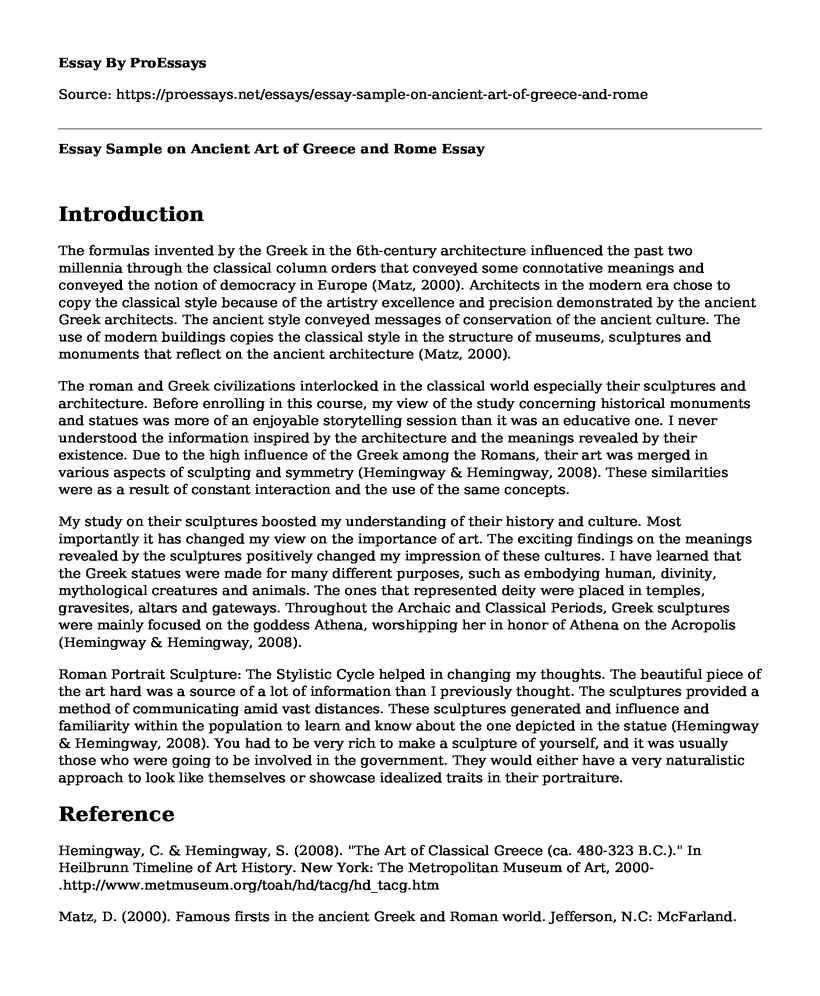Introduction
The formulas invented by the Greek in the 6th-century architecture influenced the past two millennia through the classical column orders that conveyed some connotative meanings and conveyed the notion of democracy in Europe (Matz, 2000). Architects in the modern era chose to copy the classical style because of the artistry excellence and precision demonstrated by the ancient Greek architects. The ancient style conveyed messages of conservation of the ancient culture. The use of modern buildings copies the classical style in the structure of museums, sculptures and monuments that reflect on the ancient architecture (Matz, 2000).
The roman and Greek civilizations interlocked in the classical world especially their sculptures and architecture. Before enrolling in this course, my view of the study concerning historical monuments and statues was more of an enjoyable storytelling session than it was an educative one. I never understood the information inspired by the architecture and the meanings revealed by their existence. Due to the high influence of the Greek among the Romans, their art was merged in various aspects of sculpting and symmetry (Hemingway & Hemingway, 2008). These similarities were as a result of constant interaction and the use of the same concepts.
My study on their sculptures boosted my understanding of their history and culture. Most importantly it has changed my view on the importance of art. The exciting findings on the meanings revealed by the sculptures positively changed my impression of these cultures. I have learned that the Greek statues were made for many different purposes, such as embodying human, divinity, mythological creatures and animals. The ones that represented deity were placed in temples, gravesites, altars and gateways. Throughout the Archaic and Classical Periods, Greek sculptures were mainly focused on the goddess Athena, worshipping her in honor of Athena on the Acropolis (Hemingway & Hemingway, 2008).
Roman Portrait Sculpture: The Stylistic Cycle helped in changing my thoughts. The beautiful piece of the art hard was a source of a lot of information than I previously thought. The sculptures provided a method of communicating amid vast distances. These sculptures generated and influence and familiarity within the population to learn and know about the one depicted in the statue (Hemingway & Hemingway, 2008). You had to be very rich to make a sculpture of yourself, and it was usually those who were going to be involved in the government. They would either have a very naturalistic approach to look like themselves or showcase idealized traits in their portraiture.
Reference
Hemingway, C. & Hemingway, S. (2008). "The Art of Classical Greece (ca. 480-323 B.C.)." In Heilbrunn Timeline of Art History. New York: The Metropolitan Museum of Art, 2000-.http://www.metmuseum.org/toah/hd/tacg/hd_tacg.htm
Matz, D. (2000). Famous firsts in the ancient Greek and Roman world. Jefferson, N.C: McFarland.
Cite this page
Essay Sample on Ancient Art of Greece and Rome. (2022, Jul 29). Retrieved from https://proessays.net/essays/essay-sample-on-ancient-art-of-greece-and-rome
If you are the original author of this essay and no longer wish to have it published on the ProEssays website, please click below to request its removal:
- Bayeux Tapestry, Vikings, Krak Des Chevaliers, and Roman Empire Essay
- The Artwork on Ancient Mediterranean/Egyptian - Essay Sample
- Plan of Action Towards the Company Social Media Failure
- Essay Sample on the Most Admirable Leaders of the Past: Martin Luther King Junior
- Movie Analysis Essay on Back To The Future
- Essay Sample on William Caxton: Preserving Medieval Literature and its Significant Cultures
- Essay Example on the Parthenon: Ancient Greek Culture in Athens' Acropolis







